How -to The (Ongoing) Tale of Three MG Ts, Pt. 5
There Were Several Problems With Red’s Engine Rebuild, Yellow Was Damaged & Blue Needs a Power Plant.
EDITOR’S NOTE: THIS is the fifth installment tracing different approaches to the restoration of a T Series MG. A red 1952 MG TD is getting a stock frame up restoration, a yellow 1954 MG TF is undergoing a“rolling restoration”and a once blue-and-white 1950 MG TD“parts car”is going to be fixed upasa“hotrod.” At the end we’ll compare the cost and fun factors of each of the three projects.
The Red MG’s Engine Gets Rebuilt
We rebuilt the engine in the red MG TD over a period of about nine months, working on it an average of one night every three weeks. So, we had roughly 48 hours in the job. As you can see from the following list, the parts and machining came to $4642.37, less a few bucks for the steering parts in the first order. If you figure the value of “home” labor at $20 per hour, the total cost of the rebuild was about $5600.
Back in 2003, I had a professional shop rebuild the engine in the yellow MG TF. They did not do the carburetors, but did just about everything else. They charged me $5500 back then. However, six years do bring higher prices and we have heard of a shop that gets about $10,000 for doing an MG T series engine.
When you come down to it, after you pay whatever you pay, the critical factor is whether the engine runs well and holds up. Though we haven’t put the motor in the car yet, it started and ran like silk in the Mobile Engine Test Stand and its sound was music to our ears after spending nine months with it.
My mechanic friend Vince Sauberlich excels at building all kinds of different motors and never worries whether the power plant is an OHC Sunbird four, a 1940s Dodge flathead six or an MG TD OHV four. “An engine is an engine,” he says, but even Vince will admit that we ran into a few new things and challenges in rebuilding the MG’s “XPAG”engine.
We touched on some aspects of this engine rebuild in the May and October 2011 issues, but felt this would be a good time to take an overview and stress some things that might save you time or money if you’re planning to rebuild such an engine yourself.
If you are going to do this job, you will want an MG Midget Series TD and TF Workshop Manual, which is readily available from Brit Books USA at http://britbooks.com/mgtseries.htm. While you are there, you also will want to buy The Complete MG TD Restoration Manual by Horst Schach. According to MG collectors, this book has its weaknesses, but the chapter on rebuilding the XPAG engine is not one of them. This section of the book is excellent and tells you step-by-step how to perform an MG T series engine overhaul.
Source...Parts/Service...Cost
Moss Motors Carb/MG TF steering parts....................................... $52.70
Moss Motors Parts................ $61.15
Joe Curto SU Carburetor rebuild kit..............................................$88.80
Moss Motors Engine Rebuild Kit with pistons and Crane high-lift cam.......................................$1879.82
Fondy Auto Elec. Gen./starter rebuild ..............................................$315.00
Diesel & Machine Engine machining ..............................................$550.72
Waupaca Machine Carburetor bored out ..........................................$89.65
Bumper-Bumper Plastigage, silicone for TD engine...........................$10.37
Moss Motors Tappet setlong oil hole ................................................$282.44
Moss Motors Upper Rear Engine Seal......................................... $54.41
Moss Motors Engine Rebuild 5-3175960 Pushrods, bushings, Bosch bypass valve.....................................$239.93
Bumper-Bumper Solid Plug $1.47
Advanced Distr Premium points set $22
Vendor Withheld Rebuild rocker arm assembly....................................$135
Moss Motors Engine Rebuild 8056797002..........................$203.87
Chris Mills Carburetor parts from MG Midget ........................................... $20
Diesel Machine Hone Rocker arm Stands.......................................$21.06
Family Dollar Collector car supplies ....................................................$6.33
Moss Motors Engine parts......$72.46
Advanced Distr Rebuild Distributor ................................................$117.00
Moss Motors Engine parts ......$55.67
Moss Motors Engine parts ....$304.77
Moss Motors Banjo Bolt and banjo bolt round hole............................$50.81
Family Dollar Collector car supplies ....................................................$6.94
Total $4642.37
We Started With an Aquarium Table
The first thing we faced with my engine was how to set it up to work on it.
(Author’s note: As the Schach manual and several Websites advise, you can mount the TD block on an engine stand if you want. You can use the small rocker bracket bolts from the cylinder head or any 8 x 1 mm grade 8 bolts of sufficient length and thread them into the holes made for the bell housing bolts. This attachment may not seem strong enough, but apparently it is).
The TD engine has architecture more like some prewar cars with the flywheel protected by a housing that circles the edges completely with the pan attached. You can’t remove the flywheel with the pan attached, so we decided to simply place the engine on a flat surface. I had a wrought iron table made to hold an aquarium and it was the perfect thing for supporting a TD engine.It has a frame, but no top surface, so we placed aboard across the top and set the engine on it. It was strong enough to hold a big fish tank full of water,so holding the small engine was no problem and the height was perfect.
The engine kit we ordered from Moss Motors (mossmotors.com) came with a Crane high-lift cam. We learned that a number of cams used to be available for these cars, as well as a number of different length pushrods. At the time, the only readily available parts were the Crane high-lift cam and the “long” pushrods. This turned out to be a problem, because when we assembled the valve train with these parts, there was no room for a valve lash adjustment.
We considered having the push rods machined to a different length, but that did not seem very practical. Then we noticed a footnote in the Moss Catalog that recommended the use of shims under the rocker arm pedestals when installing the long push rods. So, we had to separately order the spacers and pay extra freight on them. Now, it appears that later catalogs list various push rods.
The shims may not be a perfect solution. According to an MG T series bulletin board, they have a negative effect on valve train geometry. Some enthusiasts say that modifying the push rods or get- ting push rods sold years ago are the only ways to go. When we asked Kelvin Dodd of Moss Motors about this, he said that it’s true the shims affect valve train geometry, but he also said that unless a car was going to be raced or rallied, the shims would work OK.
We also had other problems. The rocker arm assembly was sent to a company that advertised rocker arm rebuild-ing services. When it came back, it looked like new, but it didn’t work like new. Feeler gauges indicated we had different clearances at different spots. After pondering what might be causing this, Vince decided to measure the heights of the rocker arm pedestals and there was a relatively big variation from one to the next. We had to order new pedestals from Moss and when they came, they were too tight for the shaft to pass through. The shaft had to go to the machine shop, adding time and money to the job.
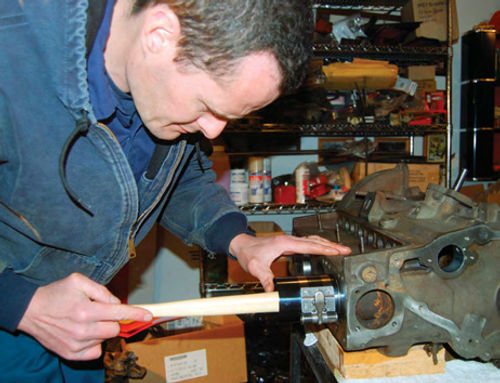
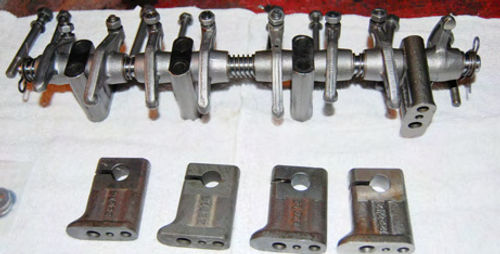
Installing piston rings raised other issues. First, the clamp bolts holding the gudgeon pins (wrist pins) had to be tightened with an open-end wrench, since a socket doesn’t fit over the clamp bolt once the connecting rod is installed onto the gudgeon pin inside the piston. Also, the big end of a rod is too large to go through the cylinders, so you cannot install the rings and push the piston and rod assembly down into a cylinder from the deck side. After looking at a couple of MG TD engine rebuilds posted on the Internet, we realized that we could first lay the block on its side. Next, we could push the piston and rod assembly up from the crankcase side of the block into the cylinder and install the rings in the piston. Then, standing above the deck, we could compress the rings and install them in the cylinder using the conventional method. This worked.
A Carburetor Communications Failure
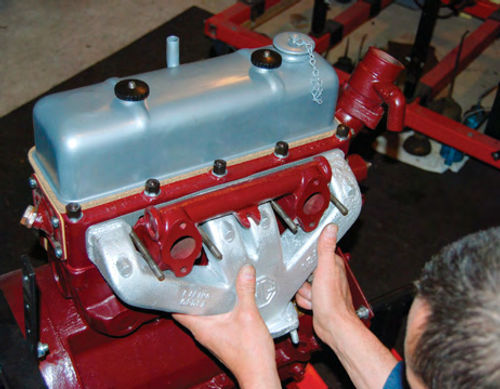
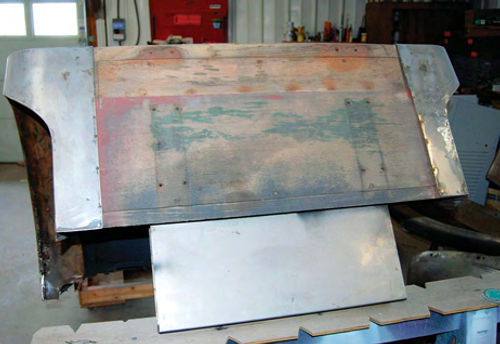
We had a “self-inflicted” problem when rebuilding the S.U. carburetors. The suction chambers or “bells” on the TD’s H2 carburetors had external dings.
Although these were on the outside, they were keeping the piston in the chamber from moving as freely as it should. We took the bells to a shop and asked them to machine the inside “just a little bit.” They did a fine job, but their idea of a “little bit” was more than ours and when they came back, the pistons were dropping too quickly. (A piston drop test is outlined in the factory workshop manual.)
This was totally our fault. We hadn’t communicated clearly to the shop how the carburetors worked and how little machining had to be done.
Luckily, British car expert Chris Mills knew how to fix the problem. He had a set of float chambers from a later MG Midget engine that interchanged with those on the TD carburetors. The Midget versions are lighter and slightly different internally, but Chris said they would work even better and our test runs indicate he was right.
Yellow Fixer-Upper Has a “Hang Up”
While working on the two disassembled cars, we have been driving the “fixer-upper” yellow car, but the way things are going, we’re not certain if this can continue or whether this car will also have to be partially dismantled (which wasn’t in the plan or the budget).
You could say we’re starting to change our thinking because of a “hangup.”
We have a 14-foot-long enclosed trailer that we use to haul around T-series MGs or two large motorcycles. We pull it with a 2009 Ford Ranger extra cab with a 4.0- liter V-6 and, although the owner’s manual says we’re within limits, the loaded trailer did tend to pull the rear of the truck down, which raises the front suspension. We were not happy with this and decided to add an equalizer hitch to level the load. A great place to get this done is Big O’s Trailers in Portage, Wisconsin, which is about two hours from home and a half-hour from my son’s place.
An appointment was made to get the trailer done and we took the yellow MG along for a visit to my son in Baraboo, Wisconsin.
When we started to off-load the car, it got about halfway down the rear ramp door before we heard a loud crunch. The muffler had snagged on the trailer door molding, damaging it and loosening (but not destroying) the entire exhaust system on the MG.
Two Good Samaritans came by and tried to help, but things just got worse. Then the parts guy from Big O’s came out, assessed the situation, walked to the front of the trailer and gave the crank on the jack a few more turns. This changed the angle of the ramp door so the car un snagged itself and rolled off. It was still drivable and we made our trip, but the exhaust note was different.
After getting the car home, we inspected it on the 4-post lift and found that the exhaust parts were actually fairly weak to begin with. We had sped up the need for a new system a bit, but realizing it would have needed doing anyway softened the blow. However, we noticed a more critical issue with the car. The timber or wooden cross member that serves as the bottom rail of the body tub support structure is badly deteriorated, bent and just about broken
This part can be purchased through the Moss Motors Catalog for $38, but the question is whether we can install it without taking the car completely apart. Our initial thought is that we can and we should also replace the gas tank backboard above it (a $30 part) at the same time. When we get around to doing these tasks, it is going to be a question of whether “some disassembly is required” or whether we’ll just have to take the whole car apart. With three cars undergoing repairs at one time, the latter is something we’d like to avoid.
Blue Hot Rod Gets Attention
People who occasionally visit our shop, Gunner’s Great Garage in Manawa, Wisconsin, are beginning to notice that our little blue hot rod MG is starting to look a little better each time they come by. Although it is still in the bits and pieces stage, more pieces are being stacked up around the car and a lot of them have new paint or polish on them. Whether you’re working on one car or three cars like we are, if a little bit gets done each day you ultimately make progress.
This car came apart hard. It was very rusty and to see these parts getting media blasted, cleaned and freshened up with new paint or a session on the wire wheel is literally amazing. For instance, we had some brass brake banjos and pipes that looked decrepit. We cleaned the heavy gunk off; media blasted them and buffed them with a fine wire wheel. Afterward, the brass banjos looked as good as new, although the mild steel piping will need to be replaced. We priced out those banjos in the Moss Motors Catalog. The forward front wheel cylinder banjos (one per side) were $120 each. The rearward ones, which have a simpler design,were $34 each. That’s a savings of $308 over buying repros!
We’ve discovered that parts made of brass (and possibly other metals) come up really shiny if you media blast them first and then run them through a fine wire wheel brush on a bench grinder. Make sure that you wear eye protection when using a brush on a bench grinder.
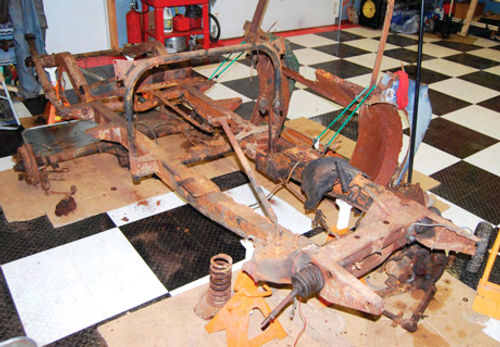
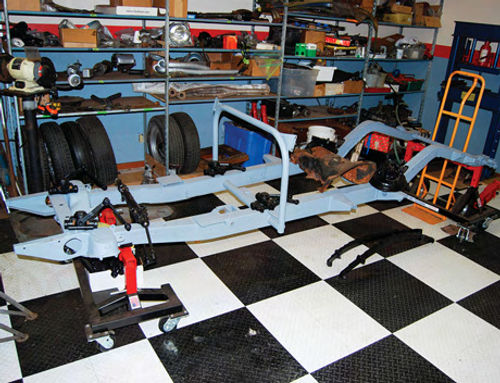
Asfaras ourplansgo foran “oldschool” power plant for the hot rod MG, we are still looking for a Ford V8-60 to use.Former NASCAR driver Rich Bickle, who now operates Muscle Up Performance & Hot Rod Shop in Janesville, Wisconsin, thought he had a disassembled one to sell us, but when we got there to pick it up, Rich apologized and told us that he did not have enough good parts left.
“My dad (Rich Bickle, Sr.) is an expert on Ford flatheads and we had 10 of the V8-60s in inventory,” Rich told us. “We completely rebuilt three motors and I thought we had enough good parts to sell you another complete motor, but as it turned out, we don’t.”
Rich said that we could buy a completely built motor for $3500 and, although this would have been a great deal, we didn’t have that much in the kitty to buy it right now. Maybe we will soon or maybe we’ll find a good one to rebuild.
















